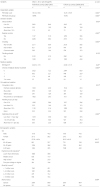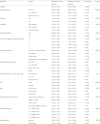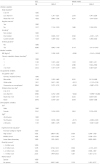2. Taylor CB, Sallis JF, Needle R. The relation of physical activity and exercise to mental health. Public Health Rep. 1985; 100:195–202. PMID:
3920718.
3. Dunn AL, Trivedi MH, O’Neal HA. Physical activity dose-response effects on outcomes of depression and anxiety. Med Sci Sports Exerc. 2001; 33(Suppl 6):587–597. DOI:
10.1097/00005768-200106001-00027.
5. Iso H, Date C, Yamamoto A, Toyoshima H, Tanabe N, Kikuchi S, et al. Perceived mental stress and mortality from cardiovascular disease among Japanese men and women. Circulation. 2002; 106:1229–1236. DOI:
10.1161/01.CIR.0000028145.58654.41. PMID:
12208798.
6. Muller-Nordhorn J, Nolte CH, Rossnagel K, Jungehulsing G, Reich A, Roll S, et al. Knowledge about risk factors for stroke: a population-based survey with 28,090 participants. Stroke. 2006; 37:946–950. DOI:
10.1161/01.STR.0000209332.96513.82. PMID:
16514090.
7. Hall MH, Casement MD, Troxel WM, Matthews KA, Bromberger JT, Kravitz HM, et al. Chronic stress is prospectively associated with sleep in midlife women: the SWAN sleep study. Sleep. 2015; 10.5665/sleep.5066.
8. Fried EI, Nesse RM, Guille C, Sen S. The differential influence of life stress on individual symptoms of depression. Acta Psychiatr Scand. 2015; doi:10.1111/acps.12395.
9. Taylor G, McNeill A, Girling A, Farley A, Lindson-Hawley N, Aveyard P. Change in mental health after smoking cessation: systematic review and meta-analysis. BMJ. 2014; doi:10.1136/bmj.g1151.
10. Choi HJ, Lee HS, Choi YH, Lee KH, Cho B, Yoo TW. The effect of exercise on daily minor stress. J Korean Acad Fam Med. 2001; 22:1034–1042.
11. Kim NJ, Suh IL. The relationship between exercise and perceived stress in employees. J Korean Soc Health Educ Promot. 2004; 21:101–115.
12. Balboa-Castillo T, León-Muñoz LM, Graciani A, Rodríguez-Artalejo F, Guallar-Castillón P. Longitudinal association of physical activity and sedentary behavior during leisure time with health-related quality of life in community-dwelling older adults. Health Qual Life Outcomes. 2011; 9:47. DOI:
10.1186/1477-7525-9-47. PMID:
21708011.
13. Faubel R, Lopez-Garcia E, Guallar-Castillón P, Balboa-Castillo T, Gutiérrez-Fisac JL, Banegas JR, et al. Sleep duration and health-related quality of life among older adults: a population-based cohort in Spain. Sleep. 2009; 32(8):1059–1068. PMID:
19725257.
14. Goldberg D. Manual of general health questionnaire. 1978. Windsor: NFER Publishing.
15. Jang SJ. Standardization of health statistical data and measurement. 2000. The Korean Society for Preventive Medicine: Seoul.
16. Tamakoshi A, Ohno Y; Group JS. Self-reported sleep duration as a predictor of all-cause mortality: results from the JACC study, Japan. Sleep. 2004; 27:51–54. PMID:
14998237.
17. Hammond EC. Some preliminary findings on physical complaints from a prospective study of 1,064,004 men and women. Am J Public Health Nations Health. 1964; 54:11–23. DOI:
10.2105/AJPH.54.1.11. PMID:
14117648.
18. Korea National Statistical Office. Korean standard classification of occupation. 2007.
19. Liang KY, Zeger SL. Longitudinal data analysis using generalized linear models. Biometrika. 1986; 73:13–22. DOI:
10.1093/biomet/73.1.13.
20. Kessler RC, Coccaro EF, Fava M, Jaeger S, Jin R, Walters E. The prevalence and correlates of DSM-IV intermittent explosive disorder in the National Comorbidity Survey Replication. Arch Gen Psychiatry. 2006; 63(6):669–678. DOI:
10.1001/archpsyc.63.6.669. PMID:
16754840.
21. Magee CA, Caputi P, Iverson DC. Relationships between self-rated health, quality of life and sleep duration in middle aged and elderly Australians. Sleep Med. 2011; 12(4):346–350. DOI:
10.1016/j.sleep.2010.09.013. PMID:
21388876.
22. Lee M-S, Shin J-S, Lee J, Lee YJ, Kim M-r, Park KB, et al. The association between mental health, chronic disease and sleep duration in Koreans: a cross-sectional study. BMC Public Health. 2015; 15:1200. DOI:
10.1186/s12889-015-2542-3. PMID:
26627637.
24. Gregory AM, Sadeh A. Sleep, emotional and behavioral difficulties in children and adolescents. Sleep Med Rev. 2012; 16(2):129–136. DOI:
10.1016/j.smrv.2011.03.007. PMID:
21676633.
25. Adrien J. Neurobiological bases for the relation between sleep and depression. Sleep Med Rev. 2002; 6(5):341–351. DOI:
10.1053/smrv.2001.0200. PMID:
12531125.
27. Charles LE, Slaven JE, Mnatsakanova A, Ma C, Violanti JM, Fekedulegn D, et al. Association of perceived stress with sleep duration and sleep quality in police officers. Int J Emerg Ment Health. 2011; 13(4):229–241. PMID:
22900457.
28. Park S, Cho MJ, Chang SM, Bae JN, Jeon HJ, Cho SJ, et al. Relationships of sleep duration with sociodemographic and health-related factors, psychiatric disorders and sleep disturbances in a community sample of Korean adults. J Sleep Res. 2010; 19(4):567–577. DOI:
10.1111/j.1365-2869.2010.00841.x. PMID:
20477953.
29. Yoon HS, Yang JJ, Song M, Lee HW, Han S, Lee SA, et al. Correlates of self-reported sleep duration in middle-aged and elderly Koreans: from the health examinees study. PLoS One. 2015; 10(5):e0123510. DOI:
10.1371/journal.pone.0123510. PMID:
25933418.
30. Hannan J, Brooten D, Youngblut JM, Hildago I, Roche R, Seagrave L. Physical activity and stress in adult Hispanics. J Am Assoc Nurse Pract. 2015; 27(2):79–86. PMID:
25708365.
31. Vankim NA, Nelson TF. Vigorous physical activity, mental health, perceived stress, and socializing among college students. Am J Health Promot. 2013; 28(1):7–15. DOI:
10.4278/ajhp.111101-QUAN-395. PMID:
23470187.
32. Reynolds D, Nicolson RI. Follow-up of an exercise-based treatment for children with reading difficulties. Dyslexia. 2007; 13:78–96. DOI:
10.1002/dys.331. PMID:
17557685.
33. Pereira DS, Queiroz BZ, Mateo EC, Assumpção AM, Felício DC, Miranda AS, et al. Interaction between cytokine gene polymorphisms and the effect of physical exercise on clinical and inflammatory parameters in older women: study protocol for a randomized controlled trial. Trials. 2012; 13:134. DOI:
10.1186/1745-6215-13-134. PMID:
22873651.
34. Grønli J, Fiske E, Murison R, Bjorvatn B, Sørensen E, Ursin R, et al. Extracellular levels of serotonin and GABA in the hippocampus after chronic mild stress in rats. A microdialysis study in an animal model of depression. Behav Brain Res. 2007; 181:42–51. DOI:
10.1016/j.bbr.2007.03.018. PMID:
17477980.
35. Mekary RA, Willett WC, Hu FB, Ding EL. Isotemporal substitution paradigm for physical activity epidemiology and weight change. Am J Epidemiol. 2009; 170(4):519–527. DOI:
10.1093/aje/kwp163. PMID:
19584129.
36. Guallar-Castillón P, Bayán-Bravo A, León-Muñoz LM, Balboa-Castillo T, López-García E, Gutierrez-Fisac JL, et al. The association of major patterns of physical activity, sedentary behavior and sleep with health-related quality of life: a cohort study. Prev Med. 2014; doi:10.1016/j.ypmed.2014.08.015.
37. An KO, Jang JY, Kim J. Sedentary behavior and sleep duration are associated with both stress symptoms and suicidal thoughts in Korean adults. Tohoku J Exp Med. 2015; 237(4):279–286. DOI:
10.1620/tjem.237.279. PMID:
26596898.
38. Kendall-Tackett K, Cong Z, Hale TW. The effect of feeding method on sleep duration, maternal well-being, and postpartum depression. Clin Lactation. 2011; 2:22–26. DOI:
10.1891/215805311807011593.
39. Brunet J, Sabiston CM, O’Loughlin E, Chaiton M, Low NC, O’Loughlin JL. Symptoms of depression are longitudinally associated with sedentary behaviors among young men but not among young women. Prev Med. 2014; 60:16–20. DOI:
10.1016/j.ypmed.2013.12.003. PMID:
24333606.
40. Teychenne M, Ball K, Salmon J. Sedentary behavior and depression among adults: a review. Int J Behav Med. 2010; 17:246–254. DOI:
10.1007/s12529-010-9075-z. PMID:
20174982.
41. Lee K, Suh C, Kim JE, Park JO. The impact of long working hours on psychosocial stress response among white-collar workers. Ind Health. 2017; 55(1):46–53. DOI:
10.2486/indhealth.2015-0173. PMID:
27498571.
42. Mäkinen T, Kestilä L, Borodulin K, Martelin T, Rahkonen O, Leino-Arjas P, et al. Occupational class differences in leisure-time physical inactivity—contribution of past and current physical workload and other working conditions. Scand J Work Environ Health. 2010; 36(1):62–70. DOI:
10.5271/sjweh.2879. PMID:
19960144.
43. Celis-Morales CA, Perez-Bravo F, Ibañez L, Salas C, Bailey ME, Gill JM. Objective vs. self-reported physical activity and sedentary time: effects of measurement method on relationships with risk biomarkers. PLoS One. 2012; 7(5):e36345. DOI:
10.1371/journal.pone.0036345. PMID:
22590532.








 PDF
PDF Citation
Citation Print
Print



 XML Download
XML Download